#pentastomida
Text
Parasitic crustaceans are wild.
[cw: photos of parasites inside host bodies]
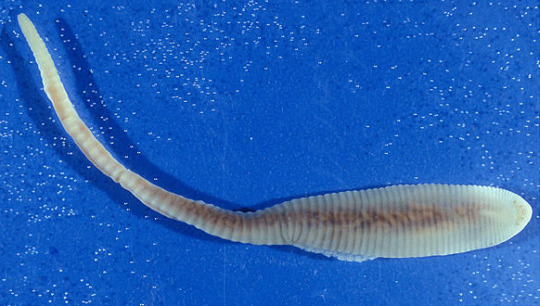
Here is Linguatula serrata, which lives inside the nose of dogs and other Carnivorans. It belongs to group Pentastomida, which has so shed its arthropod appendages that it was long classified as its own independent phylum (attested in fossils all the way from the Cambrian Explosion!), until molecular analyses showed they were in fact strange crustaceans -- closest relatives of the relatively normal-looking fish lice (Branchiura).
And then there’s Pennellidae...

Do those horn-things look like crustaceans to you? And yet the family Pennellidae is fully part of Copepoda, the chief component of crustacean plankton. Its body is simply one elongated trunk and a tiny head biting onto the fish, with two long egg cords trailing behind.
Look at the cod worm (Lernaeocera branchialis), another Pennellidae, hanging from the gills of a fish:

It’s those two red things that look like slugs wearing a wig made of soy noodles. Here’s what it looks like on its own, extracted and preserved:

(source) The coiled strings are egg masses. The slug-like part is the copepod’s trunk. The thin branching thing at the bottom is its head, converted into a sort of root system that no longer does head-like things, but rather burrows into the fish host’s blood vessels to feed its eggs. Incidentally, this is just the female; the male still looks like a regular planktonic crustacean.
Now, regular barnacles (Cirripedia) are strange enough...

(source; picture them as shrimps lying on their back, with a digestive system that fell out of the body wall but is still contained by the outer shell, and feathery legs poking out to filter water)
... but parasitic barnacles of clade Rhizocephala go much further:

Here, on the left, is Sacculina carcini. No, not the crab; the yellow sac poking out of the crab’s belly. On the right, its relative Clistosaccus paguri shows what it might look like once extracted.
Sacculina carcini is fun. A larva looks much like any other crustacean planktonic larva, until it finds a suitable host. It stings the unfortunate crab in a vulnerable spot between armor plates, and effectively injects itself into the host, leaving its own shell outside, and transferring only soft tissues.
Once inside, it grows more like a fungus than an animal, turning into a root-like web that infests the crab’s entire body, down to its leg tips. Then it takes over not only the crab’s digestive system, leeching nutrients for its own eggs, but also its nervous system, effectively controlling it like a puppet.
When the parasite is mature, its egg sac starts bulging out of the crab’s body: that’s the yellow part you see in the photo. Male Sacculina stay larvae their whole life: they just mate with the female’s egg sac and then die. The parasite makes the crab take care of itself as if it was the crab’s own eggs. There’s no competition, since the host is sterilized; to leave more food for the parasite, it also stops molting and regenerating lost limbs. If the host is male, and therefore poorly suited to carrying egg sacs under its tail, Sacculina messes with its hormones and effectively turns it female.
Finally the eggs are released and the whole cycle starts again, with the only purpose of making more eggs whose purpose is making more eggs.
(all pictures from Wikipedia unless specified otherwise)
173 notes
·
View notes
Note
just wait until you hear about the crustacean that lives in the lungs of snakes. not sea snakes. land snakes.
HATE THAT HATE THAT HATE THAT HATE THAT HATE THAT
8 notes
·
View notes
Text
IJMS, Vol. 24, Pages 12927: Characterization of the Tongue Worm, Linguatula serrata (Pentastomida), Identified from Hares (Lepus europaeus) in Romania
Linguatula serrata (Frölich, 1789) is a widespread parasite known as the tongue worm belonging to the family Linguatulidae. The adult form of the parasite is usually located in the upper respiratory tract of domestic and wild carnivores while the larval forms are located in the visceral organs of intermediate hosts (various herbivorous mammals). Twenty-four European brown hares (Lepus europaeus) were examined in this study, of which two were positive with L. serrata nymphs. The collected nymphs were examined morphologically using electron-microscopic analysis and molecularly by amplification of 18S #rRNA and COX1 genes. Lung tissue samples were also collected and histopathological examination was performed. Histopathological examination revealed the following lesions: generalized inflammatory oedema, granulomas with necrosis, calcification and fibrosis in the bronchial tree. The results of molecular sequencing for L. serrata specimens collected from the European brown hares are deposited in GenBank. This study presents the first report on Linguatula serrata nymphs collected from L. europaeus in Romania, using molecular and morphological characterization simultaneously. https://www.mdpi.com/1422-0067/24/16/12927?utm_source=dlvr.it&utm_medium=tumblr
0 notes
Photo

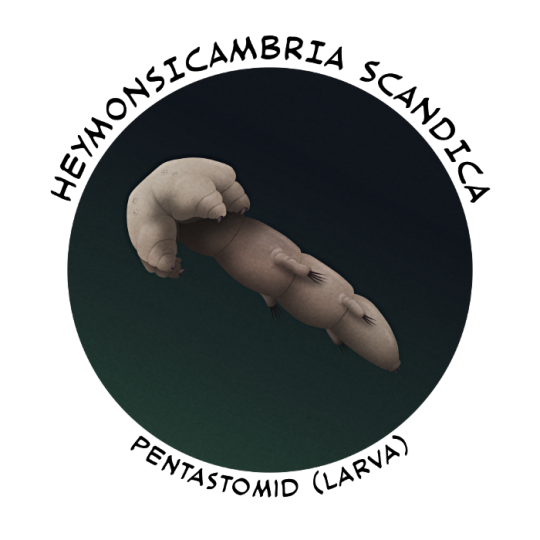
Cambrian Explosion #60: Crustacea – Larvae Larvae Everywhere
One of the characteristic features of the crustacean lineage are their larval forms, passing through various tiny larval stages. They often look nothing like their eventual adult forms and historically weren't even recognized as being the same species, with their complex lifecycles not being properly recognized until the late 1800s.
A lot of Cambrian crustaceans are only known from their larvae, preserved in exquisite microscopic detail in sites of "Orsten-type preservation". Only disarticulated fragments of larger-bodied forms have been found in a few places, and it isn't until much later in the Paleozoic that fossil crustaceans actually seem to become abundant in marine ecosystems.
It's not clear why there's such a bias in their early fossil record compared to most other arthropods, but possibly they were just very very rare animals early on. Adult forms may have mostly lived in places where they just didn't fossilize, while their tiny larvae sometimes dispersed into different environments with a better chance of preservation.
One of the earliest known of these crustacean larvae, and one of the oldest known true crustaceans, is Wujicaris muelleri.
Found in the Chinese Chengjiang fossil deposits (~518 million years ago), this microscopic larvae was just 270μm long (0.01"). It had a wide shallow head shield with a backwards-pointing spine, a pair of eyes, and another long spine projecting from its underside at the front of its body.
Like similarly-shaped modern larvae it probably lived on or just above the seafloor as meiofauna, using its developed head appendages for both locomotion and catching food particles.
For such an early example of a crustacean it's surprisingly similar to modern forms, resembling the "metanauplius" stages of some copepods and barnacles. Along with Yicaris, another larva from the same deposits, it was a probably a basal member of the major crustacean lineage that both those groups are part of: the altocrustaceans.
It suggests that some groups of crustaceans established their specific larval forms very early on in their evolution, and hit on a something that worked so well for them that they've barely needed to change it in over half a billion years.
———
The pentastomids, or "tongue worms", are a very unusual group. Small worm-like animals that almost exclusive parasitise the respiratory tracts of vertebrate hosts, outwardly they don't even look like they're arthropods – but their true affinities are revealed by their chitinous "skin" and arthropod-like nervous system.
Their evolutionary affinities have been controversial, but they're now generally considered to be highly specialized and modified crustaceans and very closely related to the parasitic fish lice. An alternate hypothesis proposes them instead as being surviving early panarthropods, related to tardigrades or lobopodians – but this is based purely on morphology, while the crustacean placement is also supported by genetic evidence.
While their fossil record is very poor, there are several different larvae known from the late Cambrian, including Heymonsicambria scandica.
Found in the Swedish Orsten Lagerstätte (~497 million years ago), this larva was about 0.5mm long (0.02"). Like other tongue worms it had four limbs on its head ending in hooked grasping claws, but unlike modern forms it also had two pairs of vestigial legs further down on its body.
It's unclear if these very early pentastomids were actually parasitic, or what their hosts would have been at the time if they were. Conodonts have been proposed as potential hosts, but they also may have initially externally parasitized other types of arthropods – a Silurian-aged fossil shows an ancient tongue worm "caught in the act" of clinging on to an ostracod.
———
Nix Illustration | Tumblr | Twitter | Patreon
#science illustration#paleontology#paleoart#palaeoblr#cambrian explosion#cambrian explosion 2021#rise of the arthropods#wujicaris#altocrustacea#heymonsicambria#pentastomida#tongue worm#ichthyostraca#oligostraca#pancrustacea#crustacean#mandibulata#euarthropoda#arthropod#panarthropoda#ecdysozoa#protostome#bilateria#eumetazoa#animalia#art#larva#parasite
119 notes
·
View notes
Photo


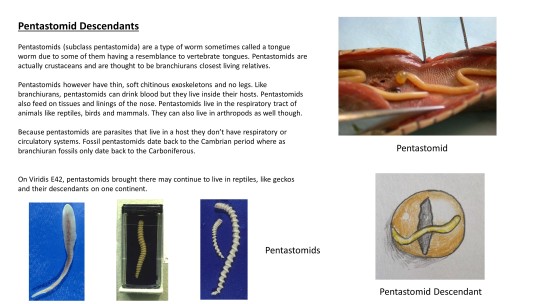
Thanks for reading or having a look. I hope you enjoy/ enjoyed.
#speculative biology#speculative zoology#speculative evolution#fish lice#branchiura#tongue worm#pentastomida#ichthyostraca#crustacean#geocarcinidae
8 notes
·
View notes
Note
I wonder if you could help me with a parasite biology question? I'm trying to find the name of a bizarre creature I saw a picture of once, but I'm coming up totally empty-handed. As far as I can remember, it looked for all the world like someone stuck an inflated rubber glove onto a human spinal column. It was definitely a parasite, and I'm pretty sure it was described as probably a hyper-reduced crustacean? I think it must have been a Pentastomida, maybe genus Armillifer, but all the ones i can find pics of are missing the really dramatic hand-shaped "head". I'm hoping you might have some idea who my mystery creature is. Thanks so much for any help you can give!
A pentastomid!

The "spinal column with a hand" is one of several forms they take, and they're even more weird (and full of lovable character) as larvae!

Whether they're related to crustaceans is still unproven and would require more intensive molecular analysis, but the only alternative hypothesis is that they're "stem arthropods" like tardigrades and lobopods (such as anomalocaris and modern velvet worms) related to a non-parasitic fossil organism, Facivermus:

Whatever they're related to, they're the predominant "parasitic worms" of birds and reptiles, adapted to their respiratory system instead of the digestive tract where most other worms hang out!
280 notes
·
View notes
Note
What are pentastomidans?
They are a subclass of parasitic crustaceans also known as “tongue worms” because they all look a lot like worms and a few of them kinda look like tongues. Their formal name (pentastomida) comes from their five appendages - one of which is actually a mouth and the other four are hooks that they use to cling to the respiratory tracts of their vertebrate hosts.

Like other crustaceans, they are chitinous - so even thought they might look kinda squishy, they aren’t (at least I don’t think they are, I haven’t touched one). They are in the class Maxillopoda along with copepods (think Plankton from Spongebob) and barnacles.
Images from Tappe & Büttner 2009: [x] [x]
23 notes
·
View notes
Photo
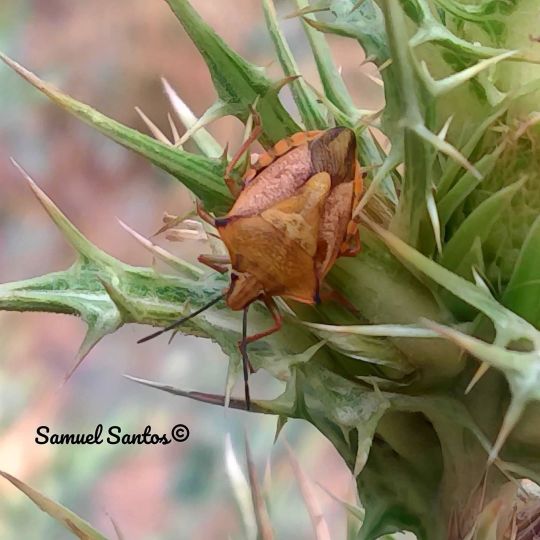
Chinche mediterranea, Carpocoris mediterraneus subsp. atlanticus, pentatomidae Comparte con otros pentatómidos (Pentatomidae) un aspecto robusto y unos colores vistosos. Destaca de su parte dorsal el color naranja moteado por manchas negras. Y no menos interesante es su parte ventral de color amarillo lima. Su pronoto es de mayor longitud y acabado en una punta por su lado extremo It shares with other pentatomids (Pentatomidae) a robust appearance and showy colors. Of its dorsal part stands out the orange color speckled by black spots. And no less interesting is its lime yellow ventral part. Its pronotum is longer and ends in a point on its extreme side. #almeria #andalucia #españa #andalousia #spain #heteroptera #chinches #bugs #hemiptera #insectsofinstagram #insectos #insects_of_our_world #instaphoto #animallovers #animalofinstagram #animales #animals #entomologia #entomology #wildlifephotography #photooftheday #photos #photographylover #photographer #fotografiaartistica #fotodeldia #pentastomidae #carpocorismediterraneusatlanticus https://www.instagram.com/p/CDj3WucKg_i/?igshid=16063l8dn8ar9
#almeria#andalucia#españa#andalousia#spain#heteroptera#chinches#bugs#hemiptera#insectsofinstagram#insectos#insects_of_our_world#instaphoto#animallovers#animalofinstagram#animales#animals#entomologia#entomology#wildlifephotography#photooftheday#photos#photographylover#photographer#fotografiaartistica#fotodeldia#pentastomidae#carpocorismediterraneusatlanticus
0 notes
Text
Tongue worms, they’re not just for reptiles…..humans too!
Tongue worm disease caused by the parasite Linguatula serrata is a blood sucking parasite that belongs to the group Pentastomida. This species generally inhabits the upper respiratory tract of terrestrial, carnivorous vertebrates. It is mainly found in reptiles and bird species.
The post Tongue worms, they’re not just for reptiles…..humans too! appeared first on AGU Blogosphere.
Tongue worms, they’re not just for reptiles…..humans too! published first on https://triviaqaweb.tumblr.com/
0 notes
Text
An ontogenetic study of lactate dehydrogenase in Porocephalus crotali (Pentastomida)
http://dlvr.it/PBf4Wk
0 notes
Link
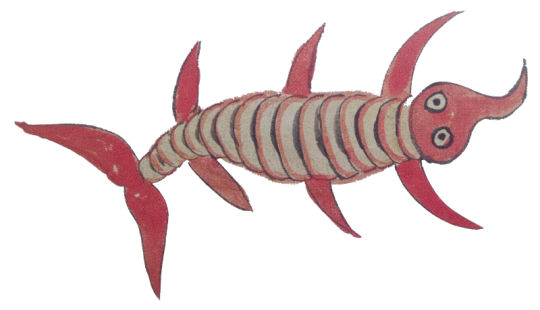
Today’s youkai parasite crawls around inside you and stabs your organs with its clawed bug legs!
By sheer coincidence (because nobody back then would have had a powerful enough microscope to know this) there is literally just one kind of internal organ parasite that ever ends up in humans and does, in fact, have clawed legs. That’s because it’s an arthropod!!!

Click to find out what the heck this is!!
97 notes
·
View notes